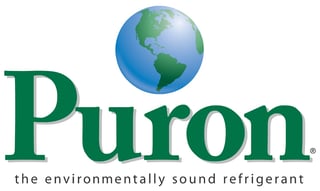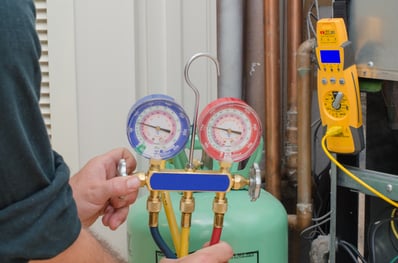Freon Vs. Puron – What You Should Know
It’s likely you’ve heard of Freon. We’ve all heard about repairs being needed when you “have a freon leak” and or need to get the “Freon recharged” in air conditioning systems on cars, for refrigerators, and for HVAC systems. Freon, also known as R-22, is the refrigerant gas used in manufacturing air conditioners and refrigeration systems for years. However, Freon is highly destructive to ozone, and as a result, our Country and Countries around the world have entered into agreements to phase out Freon in favor of other refrigerants, such as Puron. In fact, as of 2010, no new air conditioners or refrigeration systems were allowed to be manufactured in the US using Freon/R-22, and as of 2020, no new Freon can be manufactured or imported into the US.

In contrast, Puron, also known as R-410A, Suva, Forane, and EcoFluor- was approved by the EPA as a substitute for Freon. It’s much kinder to the ozone that Freon. However, it’s still on a list of things that contribute to global warming. One of the advantages is that Puron systems operate under higher pressure and use less energy overall, so in that way, they do reduce our overall energy usage and are more environmentally friendly as a result. It also means a reduction in your average energy bill, so that’s a plus.
What Does This Mean for You?

In a nutshell, if you have an air conditioner of any type that was built before 2010, it likely uses R-22. Production of R-22 is going down every year, which means the supply is down, and the price is going up as it becomes more scarce. In 2015, there is already a 90% reduction in freon on the market, escalating costs dramatically. This means repairs to older systems with freon leaks are going to get more expensive over time, until they simply won’t be able to be done anymore, with the total ban of R-22 by 2020.
So What Should You Think About?
If you have an HVAC system that has a freon leak and your system is older, you should weigh the costs of repair and begin planning for replacement of that legacy system, sooner than later.
Each year, repairs based on replacement of the refrigerant are going to get significantly more expensive. In addition, you are also spending more money on energy bills to keep the legacy system alive than a new, more efficient system would cost to run, which should factor into your decision about when to replace your system.
Replacing an R-22 Freon system with a Puron-based system is going to happen at some point, due to the fact that the Freon supply is simply drying up until it is banned completely in 2020. We hope you will consider your options, and by planning ahead, ensure that you will be able to choose the best system for your home that will also deliver maximum efficiency, saving you- and the environment- in the long run.The good news is that newer systems using Puron have higher SEER ratings and deliver better cooling using less energy. With higher efficiency, this means your energy bills should go down, as it will cost less to deliver the same level of comfort you’re used to. While replacing your home’s HVAC system is costly, the increased efficiency with newer systems that also include 2 stage heating and cooling means increased comfort year round at decreased cost. In addition, many States offer rebates for replacing legacy systems with more efficient technology, helping take some of the bite out of this cost.
Key Points – Freon
- Freon or R-22 is detrimental to the environment
- The USA and other countries around the world are phasing out Freon
- As of 2010, no new air conditioners or refrigeration systems were allowed to be manufactured in the US using Freon/R-22
- As of 2020, no new Freon can be manufactured or imported into the US
- Due to the rapid decrease in Freon production, there is a low supply of Freon, resulting in higher costs for the product every year
Key Points – Puron
- Puron was approved by the EPA as a substitution for Freon
- Puron is less detrimental to the environment
- Puron systems operate under higher pressure, and use up less energy, making them cheaper to run and more environmentally friendly
- Puron systems are becoming the standard all over the world
What Should You Do?
This really depends on what your situation is. If you are have a freon leak, or need a freon recharge…
- Call a profesional up to take a look at the system
- Depending on how much the fix costs, you could have it repaired or start to consider replacement. Some leaks can be a quick easy fix, others can cost $1000+
- Consider the amount of the (fix +the additional freon purchases), compared to (a new system + puron purchases).
- If you have an old system that has cost a lot in energy to run, ask about what energy efficient puron systems.
The main point is really this…
Short Term Solution – Keep fixing or refilling your freon-using A/C system, despite the gradual increase in freon cost, plus the additional energy costs to run it. Could be a cheap fix for the time being.
Long Term Solution – Replace your old system with a new one that runs on Puron. Puron systems are better for the environment, will cost less to run and less to refill the Puron.
If you have any more questions or would like to talk to one of our experts at Comfort Now, please feel free to give us a call at (609) 400-1005, or just click here to schedule a conversation!
Need HVAC Service?
Contact the experts at Comfort Now by Bob McAllister.
Call us at 609-493-0994!

